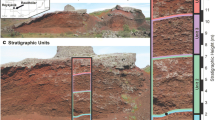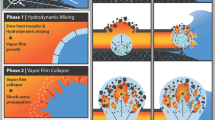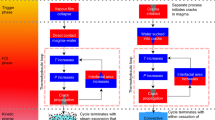Abstract
During volcanic eruptions, the interaction of magma and groundwater can produce thermohydraulic explosions capable of significantly increasing the eruption energy. The most well-known mechanism by which explosive magma–water interactions occur, molten fuel–coolant interaction (MFCI), is a complex series of macro- and microscale processes which have been simulated using laboratory-scale experiments. As a natural analog for MFCI experiments, we utilize rootless cone beds formed by lava–water explosions to estimate explosion energy. The specific mechanical energy of the lava–water explosions studied here occurs over a broader range (4 to 178 kJ/kg) than MFCI experiments and includes estimates for the highest-energy lava–water explosions studied to date. Explosion energy is partitioned similarly over the two systems, with kinetic transport and fragmentation energy making up 25–40% and 42–80% of the mechanical energy, respectively, which overlap the ranges estimated for MFCI experiments. Our study of lava–water explosions therefore provides a field-scale analog of MFCI laboratory experiments for understanding the energetics, and therefore hazards, of MFCI in natural systems.




Similar content being viewed by others
References
Austin-Erickson A, Büttner R, Dellino P, Ort MH, Zimanowski B (2008) Phreatomagmatic explosions of rhyolitic magma experimental and field evidence. J Geophys Res Solid Earth 113(B11). https://doi.org/10.1029/2008JB005731
Büttner R, Zimanowski B (1998) Physics of thermohydraulic explosions. Phys Rev E 57(5):5726–5729
Büttner R, Zimanowski B, Blumm J, Hagemann L (1998) Thermal conductivity of a volcanic rock material (olivine-melilitite) in the temperature range between 288 and 1470 K. J Volcanol Geotherm Res 80(3–4):293–302
Büttner R, Dellino P, Zimanowski B (1999) Identifying magma–water interaction from the surface features of ash particles. Nature 401(6754):688–690
Büttner R, Dellino P, La Volpe L, Lorenz V, Zimanowski B (2002) Thermohydraulic explosions in phreatomagmatic eruptions as evidenced by the comparison between pyroclasts and products from molten fuel coolant interaction experiments. J Geophys Res Solid Earth 107(B11):5–14
Büttner R, Zimanowski B, Mohrholz C-O, Kümmel R (2005) Analysis of thermohydraulic explosion energetics. J Appl Phys 98(4):043524. https://doi.org/10.1063/1.2033149
Büttner R, Dellino P, Raue H, Sonder I, Zimanowski B (2006) Stress-induced brittle fragmentation of magmatic melts theory and experiments. J Geophys Res Solid Earth 111(B8). https://doi.org/10.1029/2005JB003958
Davies T, McSaveney M (2002) Dynamic simulation of the motion of fragmenting rock avalanches. Can Geotech J 39(4):789–798
Dürig T, Dioguardi F, Büttner R, Dellino P, Mele D, Zimanowski B (2012a) A new method for the determination of the specific kinetic energy (SKE) released to pyroclastic particles at magmatic fragmentation: theory and first experimental results. Bull Volcanol 74(4):895–902
Dürig T, Sonder I, Zimanowski B, Beyrichen H, Büttner R (2012b) Generation of volcanic ash by basaltic volcanism. J Geophys Res Solid Earth 117(B1). https://doi.org/10.1029/2011JB008628
Dürig T, Gudmundsson MT, Dellino P (2015) Reconstruction of the geometry of volcanic vents by trajectory tracking of fast ejecta-the case of the Eyjafjallajökull 2010 eruption (Iceland). Earth Planets Space 67(1):1–8
Dürig T, White JDL, Murch AP, Zimanowski B, Büttner R, Mele D, Dellino P, Carey RJ, Schmidt LS, Spitznagel N (2020) Deep-sea eruptions boosted by induced fuel–coolant explosions. Nat Geosci 13(7):498–503
Ersoy O (2010) Surface area and volume measurements of volcanic ash particles by SEM stereoscopic imaging. J Volcanol Geotherm Res 190:290–296
Fagents SA, Thordarson T (2007) Rootless volcanic cones in Iceland and on Mars. In: Chapman MG (ed) The geology of Mars: evidence from Earth-based analog. Cambridge University Press, Cambridge, pp 151–177
Fagents S, Wilson L (1993) Explosive volcanic eruptions—VII. The ranges of pyroclasts ejected in transient volcanic explosions. Geophys J Int 113(2):359–370
Fagents S, Lanagan P, Greeley R (2002) Rootless cones on Mars: a consequence of lava-ground ice interaction. Geol Soc Lond, Spec Publ 202(1):295–317
Fitch EP, Fagents SA (2020) Characteristics of rootless tephra emplaced by high-energy lava–water explosions. Bull Volcanol 82(8):1–16
Fitch EP, Fagents SA, Thordarson T, Hamilton CW (2017) Fragmentation mechanisms associated with explosive lava–water interactions in a lacustrine environment. Bulletin of Volcanology 79(1)
Gansecki C, Hon K, Johnson J, Kjargaard J (2016) 2016 eruption update at Kīlauea volcano. In: Kīlauea Update Series. Volcano Video Productions, Hilo
Grady D (2008) Fragment size distributions from the dynamic fragmentation of brittle solids. Int J Impact Eng 35(12):1557–1562
Graettinger AH, Valentine GA (2017) Evidence for the relative depths and energies of phreatomagmatic explosions recorded in tephra rings. Bull Volcanol 79(88). https://doi.org/10.1007/s00445-017-1177
Greeley R, Fagents SA (2001) Icelandic pseudocraters as analogs to some volcanic cones on Mars. J Geophys Res 106(E9):20527–20546
Hamilton CW, Fitch EP, Fagents SA, Thordarson T (2017) Rootless tephra stratigraphy and emplacement processes. Bulletin of Volcanology 79(1)
Heiken G, Wohletz K (1985) Volcanic ash. University Press, California, Chicago, Harvard & MIT
Krech W (1974) The energy balance theory and rock fracture energy measurements for uniaxial tension. In: Advances in rock mechanics, proceedings, 3rd international symposium on rock mechanics, Congress, Denver: 167–173
Mastin LG (2001) A simple calculator of ballistic trajectories for blocks ejected during volcanic eruptions. U.S. Geological Survey Open-File Report 01–45: https://pubs.usgs.gov/of/2001/0045/
Mattox TN, Mangan MT (1997) Littoral hydrovolcanic explosions: a case study of lava–seawater interaction at Kilauea volcano. J Volcanol Geotherm Res 75(1–2):1–17
Németh K, Kósik S (2020) Review of explosive hydrovolcanism. Geosciences 10(2):44
Proud WG (2016) The fundamentals of blast physics. In: Bull AMJ, Clasper J, Mahone PF (eds) Blast Injury Science and Engineering: A Guide for Clinicians and Researchers. Springer, Cham pp 3–16
Sanchidrian JA, Segarra P, Lopez LM (2007) Energy components in rock blasting. Int J Rock Mech Min Sci 44(1):130–147
Sharon E, Gross SP, Fineberg J (1996) Energy dissipation in dynamic fracture. Phys Rev Lett 76(12):2117–2120
Sheridan MF, Wohletz KH (1981) Hydrovolcanic explosions: the systematics of water-pyroclast equilibration. Science 212(4501):1387–1389
Siebert L, Simkin T, Kimberly P (2011) Volcanoes of the world. Univ. of California Press, Berkeley and Los Angeles, CA
Sottili G, Taddeucci J, Palladino DM, Gaeta M, Scarlato P, Ventura G (2009) Sub-surface dynamics and eruptive styles of maars in the Colli Albani Volcanic District, Central Italy. J Volcanol Geotherm Res 180(2–4):89–202
Spitznagel N, Dürig T, Zimanowski B (2013) Trigger-and heat-transfer times measured during experimental molten-fuel-interactions. AIP Adv 3(10):102126
Taddeucci J, Sottili G, Palladino DM, Ventura G, Scarlato P (2010) A note on maar eruption energetics: current models and their application. Bull Volcanol 72(1):75–83
Valentine GA, Graettinger AH, Sonder I (2014) Explosion depths for phreatomagmatic eruptions. Geophys Res Lett 41(9):3045–3051
Wilson L (1972) Explosive volcanic eruptions-II the atmospheric trajectories of pyroclasts. Geophys J R Astron Soc 30(4):381–392
Wohletz KH (1983) Mechanisms of hydrovolcanic pyroclast formation: grain-size, scanning electron microscopy, and experimental studies. J Volcanol Geotherm Res 17(1–4):31–63
Wohletz KH (1986) Explosive magma–water interactions: thermodynamics, explosion mechanisms, and field studies. Bull Volcanol 48(5):245–264
Wohletz KH, McQueen RG (1984) Experimental studies of hydromagmatic volcanism. In: Wohletz KH, McQueen RG, Boyd FR (eds) Explosive volcanism: inception, evolution, and hazards. National Academy Press, Washington DC, pp 158–169
Wohletz KH, McQueen R, Morrissey M (1995) Experimental study of hydrovolcanism by fuel-coolant interaction analogs. NSF/JSPS AMIGO-IMI Seminar, Santa Barbara
Wohletz KH, Zimanowski B, Büttner R (2013) Magma–water interactions. In: Fagents SA, Gregg TKP, Lopes RMC (eds) Modeling volcanic processes. Cambridge University Press, New York, pp 230–257
Yokoo A, Taniguchi H, Goto A, Oshima H (2002) Energy and depth of Usu 2000 phreatic explosions. Geophys Res Lett 29(24):48–41
Zimanowski B (2001) Phreatomagmatic explosions. In: Freundt A, Rosi M (eds) From Magma to Tephra: Modeling Physical Processes of Explosive Volcanic Eruptions, Developments in Volcanology 4. Elsevier Science B.V., Amsterdam, p 336
Zimanowski B, Büttner R, Lorenz V, Häfele H-G (1997) Fragmentation of basaltic melt in the course of explosive volcanism. J Geophys Res Solid Earth 102(B1):803–814
Zimanowski B, Wohletz K, Dellino P, Büttner R (2003) The volcanic ash problem. J Volcanol Geotherm Res 122(1):1–5
Zimanowski B, Büttner R, Dellino P, White JDL, Wohletz KH (2015) Magma–water interaction and phreatomagmatic fragmentation. In: Houghton B, McNutt S, Rymer H, Stix J (eds) Sigurdsson H. Elsevier, Encyclopedia of Volcanoes, pp 473–484
Acknowledgments
This work was improved by discussions with Scott Rowland and Thorvaldur Thordarson and was supported by the University of Hawai‘i Bullard Fellowship. We are grateful to the Journal reviewers Alison Graettinger and Tobias Dürig, and associate editor Pierre-Simon Ross, for their thorough reviews of the manuscript. This work constitutes HIGP publication number 2435 and SOEST publication number 11197.
Author information
Authors and Affiliations
Corresponding author
Additional information
Editorial responsibility: P-S. Ross; Deputy Executive Editor: J. Tadeucci
Rights and permissions
About this article
Cite this article
Fitch, E.P., Fagents, S.A. Using the characteristics of rootless cone deposits to estimate the energetics of explosive lava–water interactions. Bull Volcanol 82, 83 (2020). https://doi.org/10.1007/s00445-020-01422-3
Received:
Accepted:
Published:
DOI: https://doi.org/10.1007/s00445-020-01422-3




